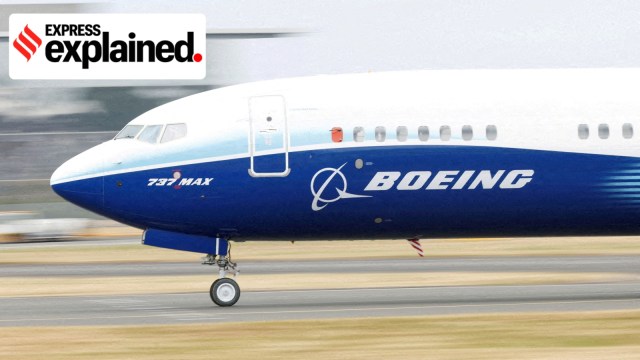- India
- International
Crashes, blowout, leadership shake-up: What explains the Boeing MAX’s issues?
Over the past few years, the 737 MAX family of Boeing aircraft has run into relentless trouble, raising serious safety concerns and hammering public confidence in the company and the aircraft.
 A Boeing 737 Max aircraft during a display at the Farnborough International Airshow, in Farnborough, Britain, July 20, 2022. (REUTERS/Peter Cziborra/File Photo)
A Boeing 737 Max aircraft during a display at the Farnborough International Airshow, in Farnborough, Britain, July 20, 2022. (REUTERS/Peter Cziborra/File Photo)The slogan, “If it’s not Boeing, I’m not going”, has long been a testament to the confidence passengers have had in the quality and safety promise of the American aerospace company. Things may not be the same any longer.
Over the past few years, the 737 MAX family of Boeing aircraft has run into relentless trouble, raising serious safety concerns and hammering public confidence in the company and the aircraft. With every problem that Boeing has fixed, a new one has emerged — the latest being a midair door plug blowout on a brand new 737 MAX 9 operated by Alaska Airlines.
A top-tier management shake-up has now been announced at Boeing.
2 CEO changes in 5 yrs
Chief Executive Officer (CEO) David Calhoun, who has been the public face of Boeing’s firefighting effort on the 737 MAX for nearly five years, will step down at the end of the year. Stan Deal, head of the commercial airplanes division has been replaced by Chief Operating Officer Stephanie Pope. Chairman of the company’s board Lawrence Kellner will not seek re-election in May, and will be replaced by former Qualcomm CEO Steve Mollenkopf.
Calhoun told employees that the Alaska Airlines incident was a “watershed moment”, and that Boeing must respond with “humility and complete transparency” and “inculcate a total commitment to safety and quality at every level of our company”.

Calhoun’s predecessor Dennis Muilenburg was ousted in 2019 following two fatal 737 MAX crashes within months of each other. Muilenburg had come under severe criticism around the world for his handling of the worst crisis in Boeing’s history.
Boeing’s mid-air panel blowout
On January 5, Alaska Airlines flight 1282 operating a 737 MAX 9 from Portland to Ontario, California, made an emergency landing soon after take-off after a mid-air door plug blowout led to a door-sized hole in the plane’s fuselage at an altitude of about 16,000 feet. None of the 171 passengers and six crew on board was seriously injured.
The door plug (or plug door) is a panel of the fuselage that is reserved for an optional emergency exit door near the rear of the aircraft. Investigations revealed that some of the bolts that keep the panel in place were missing following repair work at a Boeing facility.
The incident led to short-term groundings of 737 MAX 9s in several countries. The US aviation regulator Federal Aviation Administration (FAA) inspected Boeing’s factory near Seattle and flagged several problem areas. The FAA has asked Boeing to present an improvement plan, and is limiting production of 737 MAX aircraft in the meantime.
Boeing’s MAX problems
Launched a few years ago, the 737 MAX family quickly became very popular as a replacement for the older 737 aircraft and a competitor to the Airbus A320 family. Boeing landed orders for thousands of 737 MAXs, but just over a year after it entered service in May 2017, the promise turned into a problem for both Boeing and global aviation in general.
In October 2018, a Lion Air 737 MAX crashed in Indonesia, killing all 189 people on board. In March 2019, an Ethiopian Airlines 737 MAX crashed, killing all 157 on board, after which regulators around the world grounded MAX aircraft.
The crashes were blamed on a flaw with a newly-inducted system for pushing the aircraft nose down to prevent the plane from stalling. It was found that in the two fatal crashes, faulty sensor data led to the nose being pushed downward even though the plane was not at risk of stalling. Boeing was charged for concealing critical information about the new system from the FAA, as that would have necessitated additional training for pilots. Boeing agreed to pay $2.5 billion in fines.
After months of investigations, rectifications, and testing, the FAA cleared the 737 MAX in November 2020, and the EU’s Aviation Safety Agency followed in January 2021. India’s Directorate General of Civil Aviation (DGCA) waited until August 2021 to allow the 737 MAX to return to the skies.
Over the next couple of years, even as the 737 MAX slowly regained trust, the aircraft’s production suffered repeated problems with quality and specifications of certain parts. The Alaska Airlines incident came days after Boeing asked 737 MAX operators to carry out inspections after a loose bolt was found in the rudder control system of a plane. Rudders are vertical flight control surfaces on the tail, and are primarily used to change the airplane’s yaw, or vertical axis rotation.
‘Profits over quality’
Aviation experts, former Boeing employees, and industry watchers and analysts have argued that at the root of the crisis is Boeing’s obsession with profits, which has replaced the focus on quality and safety, the company’s mantra for decades. Boeing has denied it is prioritising lowering costs and putting profit over quality.
Critics say the turning point in Boeing’s philosophy came after the company’s 1997 merger with another American aircraft maker, McDonnell Douglas. As McDonnell Douglas executives with backgrounds in finance began taking leadership roles at Boeing, the focus shifted from engineering, quality, and safety to cost optimisation and efficiency, and ultimately, profits.
Boeing also began to see itself as more of an aircraft designer and assembler than as a manufacturer of all its parts. It perhaps made business sense to exit some operations, and Boeing began spinning off units that were engaged in “non-core” operations.
For example, Spirit AeroSystems, which was Boeing’s division in Wichita, Kansas, was spun off in 2005; it manufactures fuselages and some other parts, and is a key supplier for Boeing. Over the years, several quality-related issues with Boeing aircraft, including a few with the 737 MAX, have been traced to problems at Spirit — and Boeing is now in talks to acquire the company in order to have more direct control over the manufacturing of critical parts.
India and the 737 MAX
Indian carriers currently have just over 40 planes of the 737 MAX family, but many are on the way. The Air India group ordered 190 MAX family planes last year, and in January, Akasa Air topped up its earlier order of 76 aircraft with another 150-plane order. These are MAX 8 and MAX 10 aircraft. No Indian carrier currently operates, or plans to operate, the MAX 9 variant, which suffered the door plug blowout in January.
The DGCA is understood to be closely watching the FAA’s actions on 737 MAX, and is in touch with Boeing and the Indian carriers that operate 737 MAX variants. Out of abundant caution, the regulator had ordered inspection of emergency exits on all 737 MAXs in India after the door plug blowout.
A headache for Indian carriers could emerge if the crisis at Boeing and the FAA’s ongoing scrutiny starts affecting aircraft delivery schedules, in addition to the safety concerns. So far, both Akasa and the Air India group have expressed faith in Boeing and the aircraft.
More Explained
EXPRESS OPINION
Apr 04: Latest News
- 01
- 02
- 03
- 04
- 05































